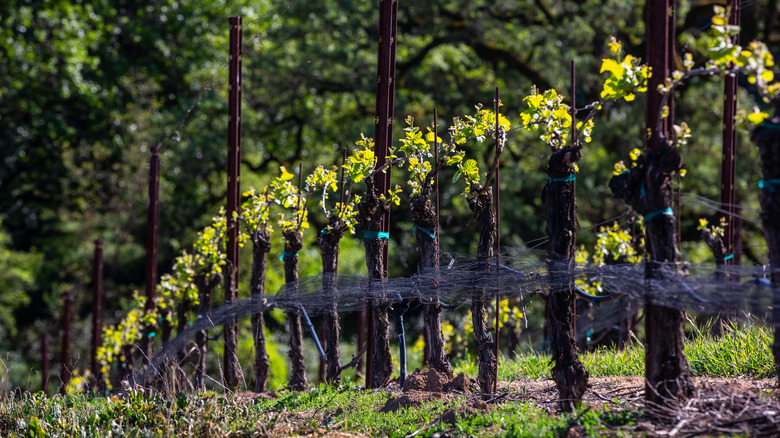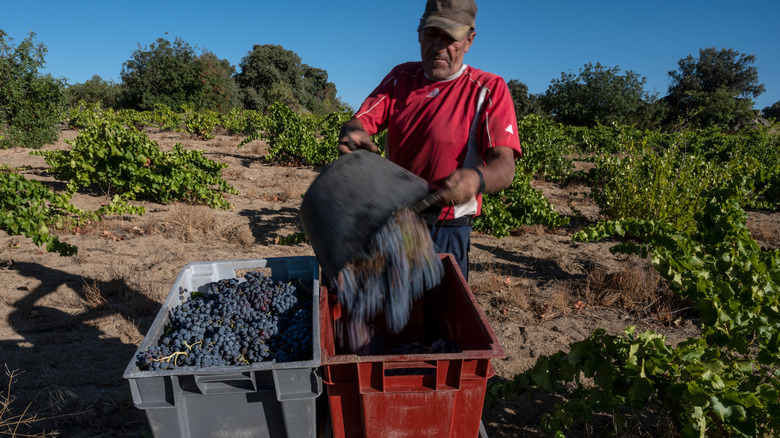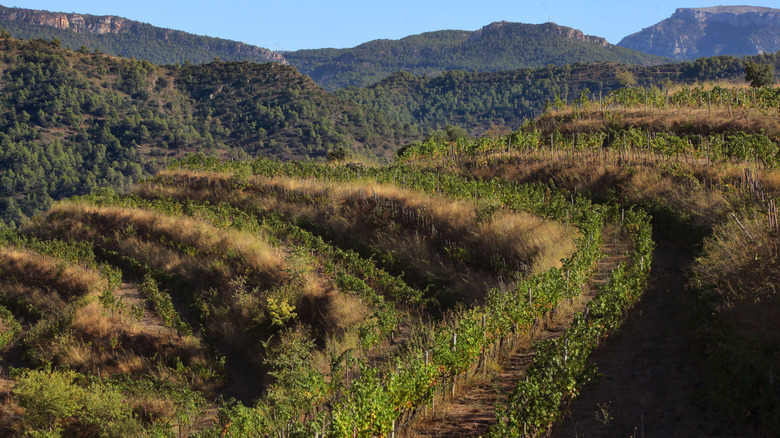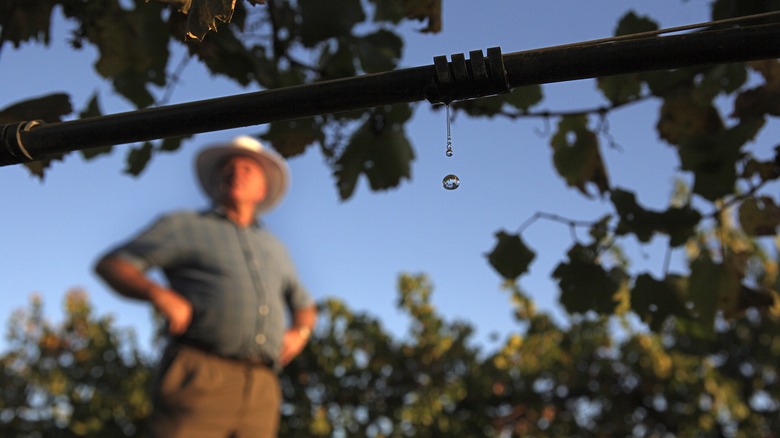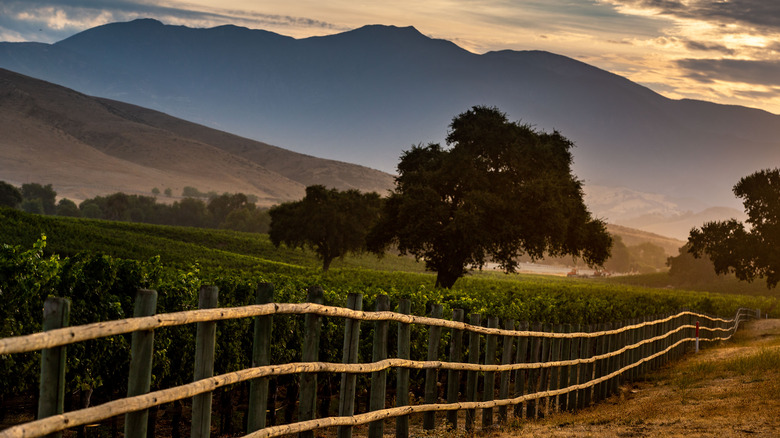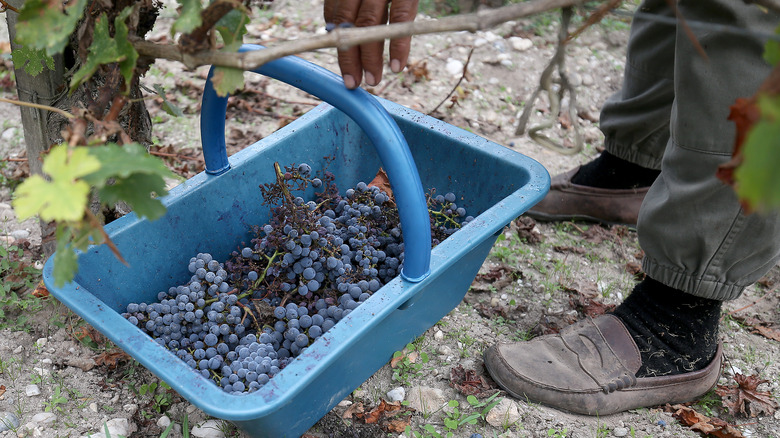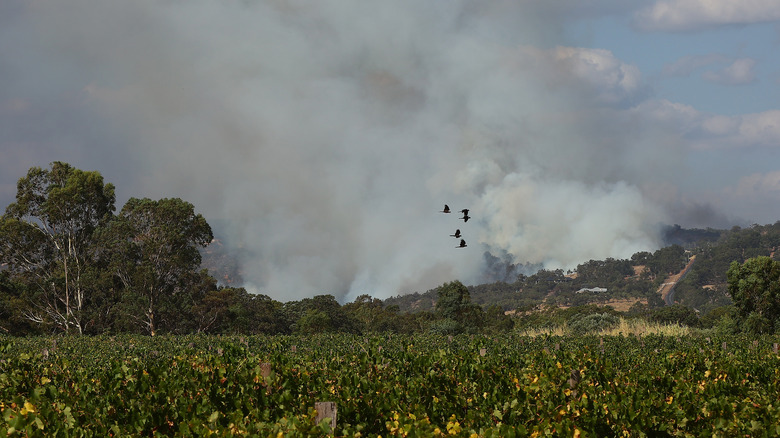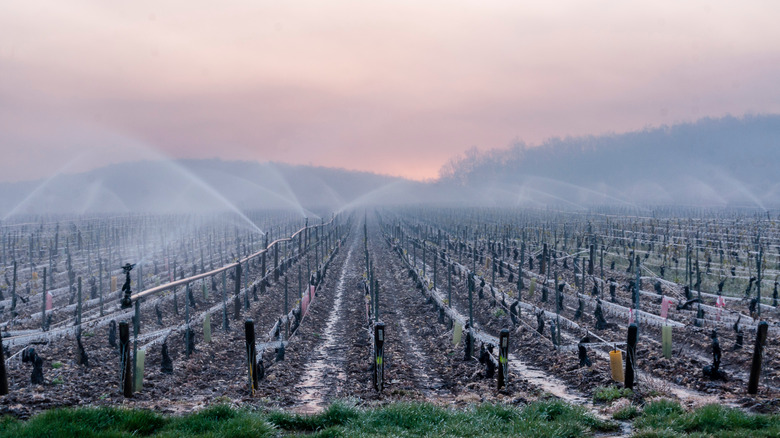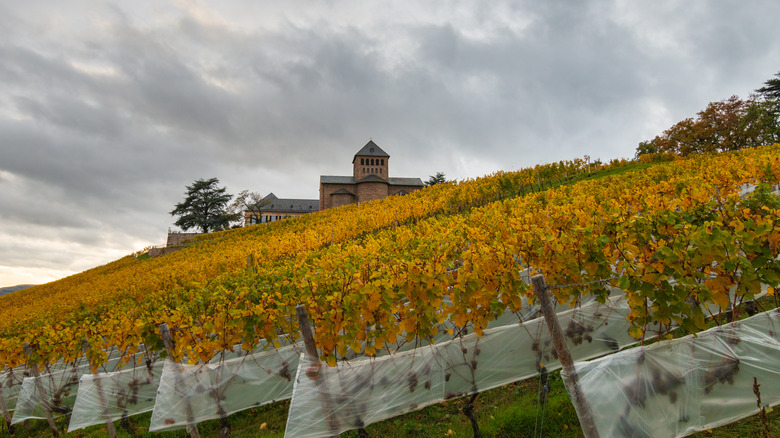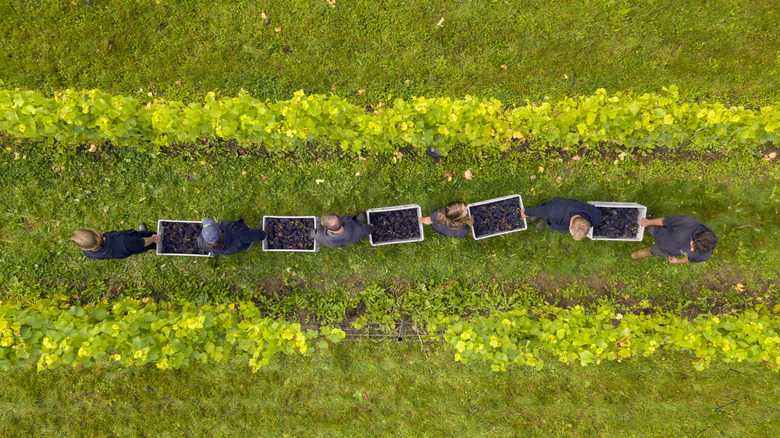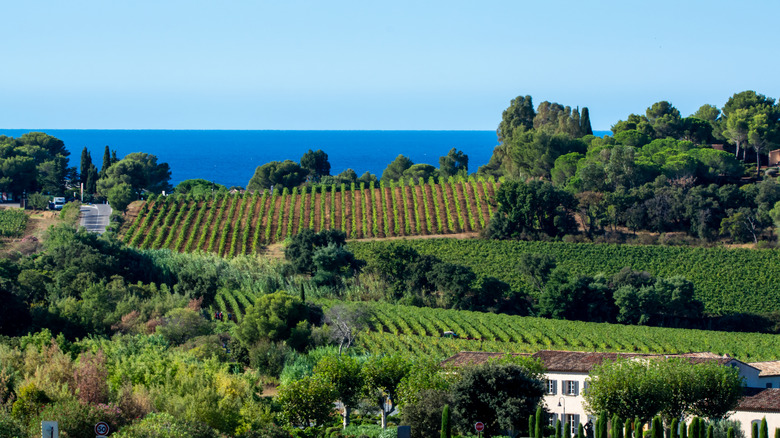10 Ways Climate Change Is Threatening The World's Wine Industry
2011 to 2020 was the warmest decade on record for planet Earth, according to United Nations. The global wine industry, which is largely the product of the growing environment of each vineyard within unique production regions, is reporting that changes in the climate are impacting traditional methods and expectations. This goes beyond rising temperatures. "Because the Earth is a system, where everything is connected, changes in one area can influence changes in all others," (via United Nations).
Droughts, devastating fires, water scarcity, extreme weather incidents, and threats to biodiversity are often considered impacts of the changing climate. There are instances around the world where each of these occurrences — along with other circumstances — are threatening and altering the global wine industry in various ways. This is a reflection of broader conditions within the agricultural landscape, "because viticulture is sensitive to climate and is concentrated in Mediterranean climate regions that are global biodiversity hotspots," notes Proceedings of the National Academy of Sciences. Here are some of the most documented instances and what's being done by the world's growers and winemakers to mitigate or adapt to changes in climate.
Harvest patterns of Spanish growers are altered by heatwaves
The 2022 harvest in Spain is being reported by some wineries as the earliest on record, and they are blaming harsh heat for the advancement of grape picking to earlier in the season (via The Drinks Business). All of Europe has experienced extreme temperatures throughout the summer of 2022, sometimes disrupting the maturity patterns of wine grapes, obliging pickers to remove them from the vine earlier in the season to retain the flavors and freshness that consumers expect.
And it's not just the heat. The conditions in Spain and nearby Portugal are also impacted by water scarcity. According to a study in Nature Geoscience journal, "grape-growing regions across the Iberian Peninsula are projected to decrease in the area between 25% and 99% by 2050 due to severe water deficits that render land unsuitable for viticulture." Hopefully, the wine industry will find mitigation solutions to prevent that outcome. For the 2022 vintage, adaptation comes in the form of earlier harvests as well as nighttime picking, when temperatures are more comfortable for people working in the vines. They also keep the harvested fruit fresh, which conserves integrity in the crucial time period before they are processed in the cellar.
And...these heatwaves cause growers to consider cooler growing areas
But what happens if, as the Nature Geoscience journal report suggests, vineyards are forced out of their current locations by inhospitable conditions? Or if producers look to diverse regions and grape varieties to consider new styles? In Spain and elsewhere around the world, growers are constantly evaluating new spots to plant grapes, often in higher elevations that help moderate the climate. According to World Wildlife Fund, "As the major European wine producer closest to the equator, Spain is particularly vulnerable to climatic changes."
Spain has always been a diverse country, viticulturally. According to reporting in Wine Enthusiast, growers in Priorat, Rioja, Ribera del Duero, and elsewhere have sought out lifted heights for vineyards, suggesting that "elevation might be the most important ingredient of regional terroir." In many instances, these growing areas are traditional and not solely influenced by changes in climate, however, some producers have begun to search for frontier-level high-elevation sites for new plantings to take advantage of the conditions afforded by altitude.
Warm temperatures in Australia might encourage new varieties
Wine lovers know that certain grapes thrive in particular regions and that all varieties will produce unique profiles depending on where they are grown. As grapes ripen, winemakers look for the perfect balance of sugar and acidity, but when grapes mature too quickly (or too slowly) the conditions in the growing environment can make them less than ideal for a top-quality wine. Understanding this is part of the skillset of wine growers and makers, but one of the baffling challenges of the current winemaking landscape in Australia is rising temperatures.
According to reporting in The Sydney Morning Herald, grapes that prefer cooler climates may not continue to deliver the wines that enthusiasts are accustomed to. This has encouraged vintners in Australia to consider grapes that thrive in the Mediterranean and other areas that experience hot and dry weather. Australian Grape & Wine has a plan in place called Sustainable Winegrowing Australia to help growers make environmentally sustainable choices which will help communicate to consumers the management choices, such as vineyard management, that may present future-focused changes.
California growers continue to face water shortages
One of the world's most acclaimed wine regions has been in a drought for years, a challenging circumstance that's predicted to continue. According to California Water Watch, in 2022, rainfall was at 76% of the historical average, and reservoir storage was at 69% of the historical average. "A growing body of evidence is starting to show that our current drought is an extension of the 2012-2016 drought, interrupted by just a few wet years," (via California Water Watch).
Through continued dry periods historically occurring in parts of California, there are several layers to this problem that are impacting the wine industry. Water efficiency should be a top priority for wineries and vineyards. This not only means reconsideration of irrigation practices, if that's part of the vineyard management system, but also winery functionality. On average, California wineries consume 2.5 gallons to 6 gallons of water for each gallon of wine made (much of it is used for cleaning). And that's only after the grapes have been harvested. The Teaching and Research Winery at the University of California Davis is working on moving the needle on this condition to 1 gallon of water for every gallon of wine.
Due to rising temperatures, Bordeaux approves new grape varieties
France's Bordeaux region is one of the world's most historic wine-producing environments, and it's also an industry built largely on blends rather than single variety releases. For generations, Bordeaux has championed a specific set of wine grapes: cabernet sauvignon, cabernet franc, merlot, malbec, carmenere, and petit verdot for red wine, and semillon, sauvignon blanc, sauvignon gris, muscadelle, colombard, ugni blanc, merlot blanc, and mauzac for white wines.
But in 2021, the governing body Institut National de l'Origine et de la Qualite (INAO), approved six new varieties that can be planted and blended into wines from the region. Consider this a probationary period — with limits on labeling, blending, and planting — but it's the start of evaluating the practical use of new varieties that thrive in hotter weather and shorter growth cycles. These newly accepted grapes are arinarnoa, Castets, marselan, and touriga nacional for reds, and alvarinho and liliorila for whites, notes The Somm Journal.
Regions impacted by fires evaluate the impact on harvested grapes
According to Wine Australia, there are three main branches to consider when it comes to fire impact in the vineyard: preparing for the fire season, vine recovery following a fire, and evaluation of smoke impact. This last one might be the least obvious to consumers visually, but has a potential long-term influence on the finished wine. This happens when volatile phenols released by burning wood infuse the grape skins. Until the grapes are fermented, this might not be apparent, but when the phenols make themselves known, it's with a distinct flavor that some people experience as medicinal. Because red grapes are more likely to be fermented on their skins, this is often a factor in red wine production.
Grapes exposed to smoke during any phase of development might be affected, with the final stretch of ripening from the onset of color change (called verasion) to harvest being the most delicate time frame. "Smoke taint risk also depends on other factors such as intensity and duration of the fire, proximity of the vineyard to the fire, prevailing weather conditions and grape variety," (via Wine Australia). While an experienced winemaker can apply their own analysis to potentially smoke tainted grapes, the industry standard relies on lab work which can create a time-sensitive backlog when fires are extensive.
In Burgundy, extreme weather events prompt a variety of adaptations
Consulting with winemakers around the world, it's often apparent that there's not one thing that consistently signals climate change (it's the abnormality, consistency, and drastic nature of the events that all factor in, notes NASA). In fact, there are places that report extreme weather incidents are the most threatening yet varied occurrences. In Burgundy, one of France's most prestigious and historical wine-growing regions, the damage often comes delivered by spring frost and hail.
Grapevines experience a spring cycle of budbreak, when the flowers that will result in grape growth appear. If the budbreak occurs earlier due to a warm spring season, the vines can be vulnerable to a destructive frost that eliminates the development of fruit. When this happens, as it did in Chablis and elsewhere in 2022, vignerons turn to candles, fans, and electric heating wires to protect crops. They also use a counterintuitive method of spraying the vines to form a protective bubble of ice that encases the buds in space with a relatively lower temperature. Most of these efforts are costly and rolled out at times of stress and pressure, but if they can save all or part of a vintage, many agree these are worthwhile efforts.
German ice wine is harder to produce in most vintages
Eiswein, or ice wine, is a unique German product that is made when the grape berries are left to freeze on the vine. This concentrates the fruit and acidity, making a very delicious and increasingly rare sip. The temperature must drop to at least 19 degrees Fahrenheit in order to make eiswein, but the ideal zone is between 12 to 14 degrees Fahrenheit, according to Wines of Germany. This cold environment creates a naturally icy grape, with the water trapped inside in solid form when it is harvested (this often happens early on a winter morning). The resulting press is only juice, which freezes at a lower point than the water, used to make a highly concentrated and sweet wine.
If conditions aren't cold enough, then the vintage will produce little or no eiswein. While Germany is largely considered a cool climate region, with a long history of crafting ice wine each winter, the past several years have been too warm. While rising temperatures have enabled German growers to produce exceptional dry wines over recent years, the eiswein style has been reduced. According to Wine Enthusiast, only one German winemaker was able to make eiswein during the 2020 vintage.
Rising temperatures drive vineyard plantings to unexpected regions
Changes in climate have nudged vineyard growers to look to new areas, such as the higher elevations mentioned above, but also presented opportunities to move into areas previously thought to be limiting for viticulture. Typically, grapes have been grown on both the northern and southern hemispheres in two bands between 30 and 50 degrees latitude, (via Wine & Spirit Education Trust). But as the climate changes, vineyards are able to thrive outside of this historical zone.
A prime example is England, one of the most interesting regions for sparkling wine at the moment. While this generation isn't the first to cultivate vineyards in Great Britain, the current movement has received international acclaim, supporting more than 800 vineyards, according to Wines of Great Britain. China, Scandinavia, Belgium, and other unexpected places are also gaining attention for vineyard plantings (via Beverage Trade Network), and Bhutan Wine Company will initiate the kingdom's first wine grape harvest in 2023.
Provençal winemakers deal with heat
In the historical southern French region of Provence, the wine industry is supported by the Centre de Recherche et d'Expérimentation sur le Vin Rosé (Rosé Research Center). The efforts of the center are aimed at supporting vineyard growers and winemakers, and one priority is planning for hotter, dryer growing conditions. "Over the last century, average temperatures in the region increased 2.52 F," according to Vins de Provence. "The rate of temperature change is surging, and in just the next 80 years, Provence expects to see higher temperatures, between an additional 3.6-to-10.8 F."
To cope with this, vignerons are adapting canopy management plans which provide more shade to developing berries and improve water efficiency within the leaves. Cover crop managed seasonally between the vine rows, also helps with moisture control within the soil. And irrigation, once forbidden in Provence, is now allowed on a limited basis in places where it is available. Many growers across southern France are also working with different varieties to evaluate the potential that grape diversity offers in a changing climate.
